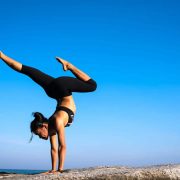A Balanced Athlete is a Stronger Athlete
When it comes to creating a more complete athlete, the foundation needs to stem from balance. The concept of core body strength and functional integration is recently discussed in every form of media and across all spectrums of athletics. However, what is not addressed in these discussions is how an athlete’s lack of symmetry in all three planes – frontal (front to back), sagittal (left and right) and transverse (top and bottom) is actually an inefficient and injury prone athlete.
How Muscular Imbalances Occur and the Problems It Creates
As an athlete, sport specific training requires certain ranges of motion (involving more than one muscle group and associated joint) that are completed to improve the skills necessary for optimum performance. By recognizing that each movement within the muscles involves a concentric action (the muscle shortens and acceleration of the body part) and an eccentric action (the muscle lengthens to decelerate the body part), and that movement requires traveling through more than one plane (mentioned above), you immediately see how important it is to focus on true functional integration.
To perform actions specific to sport, the primary moving muscles tend to become over developed at the expense of the antagonist muscles limiting the range of motion that can be performed by the necessary muscle groups. Muscular imbalances can create the following symptoms: Decreased power output: the primary mover does not allow the antagonist muscle to complement the range of motion. If the quads are overly tight, the hamstrings will not become fully engaged which limits the total power output of the upper leg. Decreased endurance: if the primary mover is overly tight, the antagonist muscle can not bring the muscle back to its proper position which increases resistance and ultimately creates fatigue within the muscle. Decreased economy: if there is limited range of motion within a muscle, the body will compensate to perform the movement in a non-biomechanically efficient manner Increased risk of injury: a tight muscle is similar to a rubber band that has been pulled tightly, the tension in the middle becomes high and is susceptible to tearing if asked to extend beyond it’s capable range of motion (verses it’s optimum range of motion).
Proprioceptive Balance – the Foundation to Muscular Integration
As athletes, we understand that the core is the foundation for all of our movements – nearly every movement originates (directly or indirectly) from your core. As you move specific to your sport, your core strives to maintain balance and provides a foundation for the other muscles to interact with for correct biomechanics and ultimately optimum strength and endurance. To ensure that you are forcing your sport specific muscle groups to engage in a more functional way (i.e. through all three planes), you have to incorporate a Proprioceptive Strength Program into your cross training exercise program.
Let’s illustrate what Proprioceptive Balance actually “feels” like. Simply stand on one leg and close your eyes with your head facing forward. As your core strives to maintain balance (i.e. not fall over), you will feel the functional integration of the muscles starting at the foot and coming all the way up into your gluts, core and lower back. This is Proprioceptive Balance in a nut shell. Your body makes these subtle adjustments every time you cross train or participate in your sport. However, you are moving so fast, you don’t “feel” the balance taking place. [Side note: now try the exercise again, but this time tighten up your abdominal muscles so that you feel like you are piercing your spine with your belly button and notice how much more stability you have!]
Tools to Create Proprioceptive Balance and True Muscle Integration
There are a few productive tools that we use with all of our athletes: Indo-Board™ with free weights – click here for a video example Bosu Ball™ with free weights Folded towel with free weights Single leg with free weights
Workouts to Teach Proprioceptive Balance
To help force the body to work in all three planes, enhance the athlete’s proprioceptive balance and integrate more muscles we have our athletes complete all strength exercises on the Indo-Board™ without letting either side of the board touch the ground. Let’s look at the shoulder press on the Indo-Board™ with a squat. By having the athlete complete a traditional shoulder press while on the board forces the core to create balance in two planes: front/back as well as left/right. The gluts (back of body) are engaged with quads (front of the body) to avoid falling forwards or backwards. The shoulders – particularly the middle deltoids are working to lift the weight, while the anterior and posterior deltoids (the front and back of the shoulder joint) are working to keep the weight from falling forwards or backwards. After you complete the shoulder press, you then perform a squat while standing on the Indo-Board™ and you force your quads (front) and your hamstring (back) to integrate together to avoid falling off of the board (in all directions). By involving so many muscles to complete a shoulder press and squat will develop true muscular integration.
Push – Pull Sprint Interval Set
We also have our athletes incorporate a workout we call Push-Pull-Sprint Intervals. For this workout, you will need access to a Concept 2 Rower™ (most gyms now have one or two units available to their members).
The athlete begins the workout by completing as many push ups on the Indo-Board™ as possible in 30 seconds (with the goal being not to let either side touch the ground) Immediately move to pull ups and complete as many repetitions possible in 30 seconds Immediately move to the Concept 2 Rower™ and complete a 500 meter sprint (capture your elapsed time). Rest five minutes and repeat five times. The overal of this set is to have the smallest deviation in your numbers from Set #1 – Set #5.
If you would like a sport specific proprioceptive training plan & instructional video series, please email me directly at robb@coachrobb.com.


